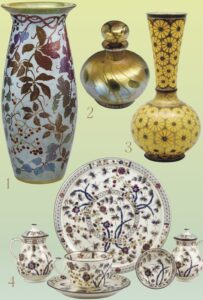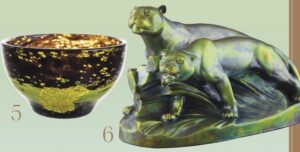
I saw this exhibition at Panasonic Museum in Shiodome.
The Budapest Museum has a great collection of Ceramics and Glassworks.
This exhibit focuses on these arty craftworks produced from the late 19c to the early 20c and tries to describe how big influence came from the traditional Japanese ceramic works. All works in this exhibition are art nouveau style, very elegant, feminine, delicate, and sophisticated.

I’m impressed with some glaze technology during that period. They are called Eosin coloring and Raster coloring. The pottery or glass works made by these techniques wear a metallic glow and are full of luxurious charm. At a glance, the glazed vases or dishes seem like ordinary ceramic, however, depending on the angle of the light, they emit metallic glamorous seven colors of reflection.
Moreover, I’m happy to know about the favrile glass in this exhibition. Favrile glass is a type of iridescent art glass developed by Louis Comfort Tiffany. The iridescent glass has a color that is ingrained in the glass itself, as well as having distinctive coloring.

Not only the ceramic technique but the motifs of these ceramics and glassworks are influenced by Japanese traditional ceramic work. Most of the artifacts have a streamlined style, and they are inspired by the shape of plants and animals.
The main difference between Japanese ceramics and western is in the sense of colour. Japanese ceramics are pale and delicate coloured, whereas Western ceramics are brightly coloured with clear contrasts.
I recommend this exhibition because we can learn about the history between Europe and Japan through beautiful art works.
Exhibition Info: https://panasonic.co.jp/ew/museum/en/